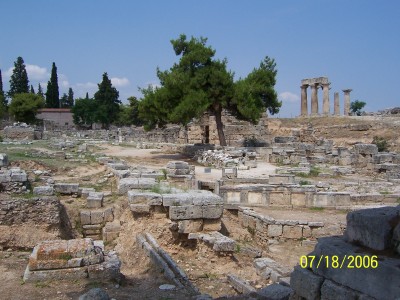|
The content on this website is maintained by
Robert Myallis, pastor at Zion's Lutheran Church, of Jonestown, PA.
The photos were taken by
Emily Myallis, a diaconal minister in the ELCA who also serves at Zion's Lutheran.
This website and travel to
Greece was made possible by a grant from the
Fund for Theological Education,
which provides grants to assist the education and formation of
Christian leaders from numerous denominations.
Bible quotes are taken from the New
Revised Standard Version, unless cites otherwise.
The above photo of Greece comes from
NASA; The icon of Saint Paul comes from George Mitrevski's website. |
 |
|
Meat
Market
 On the
right side of the picture is the temple to Apollo. In the middle
is a road with a building on the right (the black rectangle is
the doorway; a tree stands next to it). Along the road was a
stoa (portico) which housed an agora (market). Even though the
old part of the city was only about 300 meters long on each
side, there were three markets and nearly 10 temples (in
addition to main governmental buildings). The temples and the
markets, some of which sold meat, were located right next door
to each other. On the
right side of the picture is the temple to Apollo. In the middle
is a road with a building on the right (the black rectangle is
the doorway; a tree stands next to it). Along the road was a
stoa (portico) which housed an agora (market). Even though the
old part of the city was only about 300 meters long on each
side, there were three markets and nearly 10 temples (in
addition to main governmental buildings). The temples and the
markets, some of which sold meat, were located right next door
to each other.
Often food was sacrificed to the gods in temples. Part of the
animal was burned as a sacrifice and the rest (the edible meat)
was eaten by people participating in a meal. Some of the meat
would also be sold in the meat markets across the streets.
How are the meat markets significant
for understanding the world of Paul?
The meat market created two problems for the Christians in
Corinth. Some of the Christians were wealthy enough to attend
these sacrificial meals at the temples. Under the thought that
“we know that "an idol in this world is nothing," and that
"there is no God but one,” they thought they could eat the food
sacrificed to the gods (Paul quotes the Corinthians' own words
in his letter; 1 Corinthians, chapter 8:4).
For those of all classes, the question of eating meat from the
meat markets came up. Could they eat meat that may or may not
have been sacrificed to idols?
The close proximity of the meat markets and the meat meals at
the temples proved a vexing issue for Paul and the Christians at
Corinth.
 How is Paul confronting his culture?
How is Paul confronting his culture?
Paul makes an extended
argument in his first letter (3 chapters) about the nature of
Christian freedom to argue that Christians could not participate
in pagan sacrificial meals and the communion:
You cannot drink the cup of the Lord and the cup of demons.
You cannot take part in the table of the Lord and the table of
demons (Chapter 10:21)
However, on the question of the food at the market (which might
have been served anywhere in town!), Paul gives something of a
green light.
If an unbeliever invites
you to a meal and you are disposed to go, eat whatever is set
before you without raising any question on the ground of
conscience. But if someone says to you, "This has been offered
in sacrifice," then do not eat it, out of consideration for the
one who informed you, and for the sake [their] conscience --
(Chapter 10:27-28).
Here Paul is threading the needle, trying to give Christians
guidance on this tricky issue.
source:
info on meat
markets: Hays, Richard. First Corinthians,
Interpretation, a Commentary. Nashville:
Westminster, 1997.
|
|
 |



 On the
right side of the picture is the temple to Apollo. In the middle
is a road with a building on the right (the black rectangle is
the doorway; a tree stands next to it). Along the road was a
stoa (portico) which housed an agora (market). Even though the
old part of the city was only about 300 meters long on each
side, there were three markets and nearly 10 temples (in
addition to main governmental buildings). The temples and the
markets, some of which sold meat, were located right next door
to each other.
On the
right side of the picture is the temple to Apollo. In the middle
is a road with a building on the right (the black rectangle is
the doorway; a tree stands next to it). Along the road was a
stoa (portico) which housed an agora (market). Even though the
old part of the city was only about 300 meters long on each
side, there were three markets and nearly 10 temples (in
addition to main governmental buildings). The temples and the
markets, some of which sold meat, were located right next door
to each other.